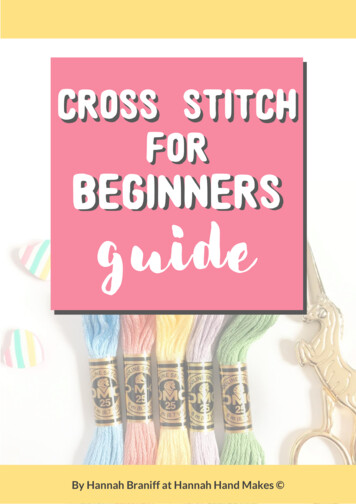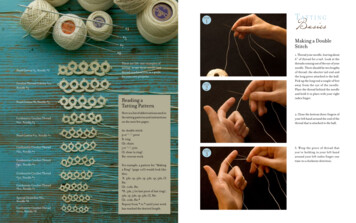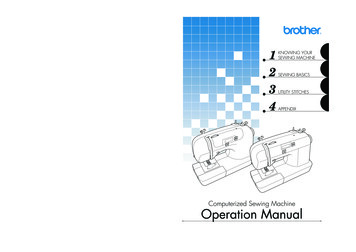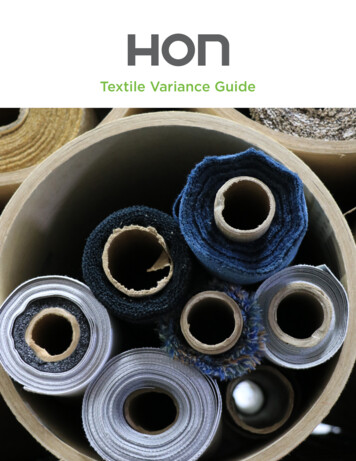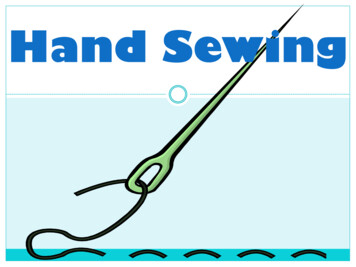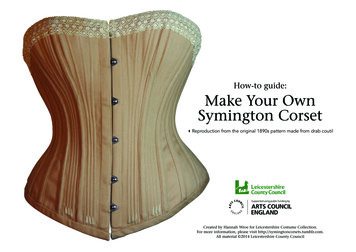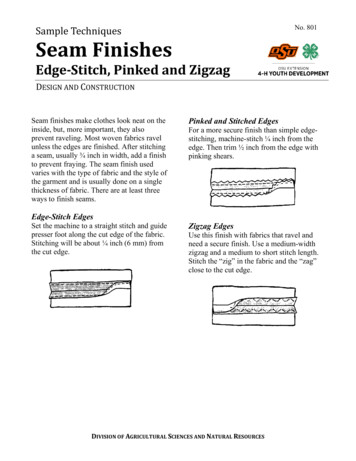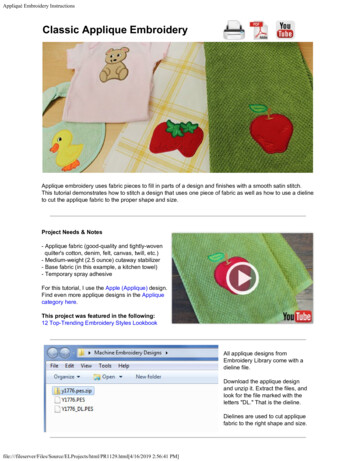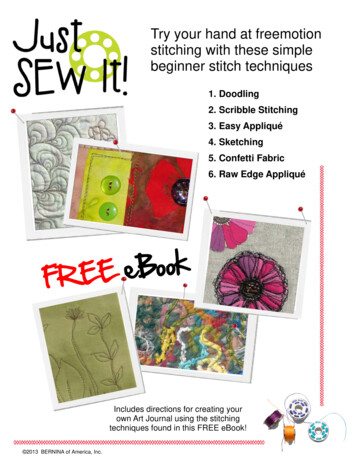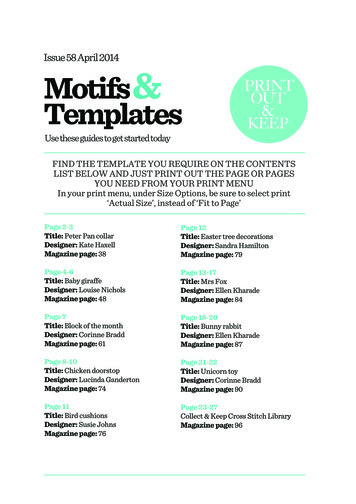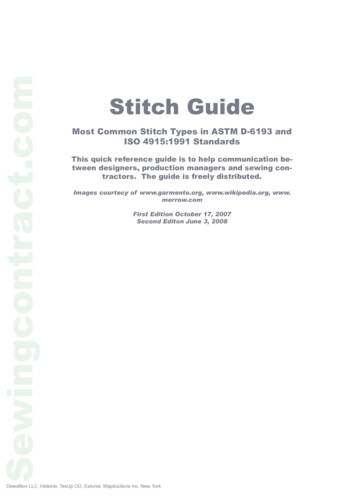
Transcription
Sewingcontract.comStitch GuideMost Common Stitch Types in ASTM D-6193 andISO 4915:1991 StandardsThis quick reference guide is to help communication between designers, production managers and sewing contractors. The guide is freely distributed.Images courtecy of www.garmento.org, www.wikipedia.org, www.merrow.comFirst Edition October 17, 2007Second Editon June 3, 2008Dewellton LLC, Helsinki, TexUp OÜ, Estonia, Wapductions Inc. New York
ASTM D-6193ISO101ISO# 101 Chainstitch103ISO# 103 BlindstitchStitch is formed with one needle thread whichinterloops with itself on the top surface of the material. The thread passes through the top ply andhorizontally through portions of the bottom ply.One thread Blinstitch for hemming, See page 4301Sewingcontract.com104 BlindstitchStitch formed by a needle thread passing throughthe material and interlooping with itself on theunderside of the seam.ISO# 301 LockstitchStitch formed by a needle thread passing throughthe material and interlocking with a bobbin thread.Threads are meeting in the center of the seam.Stitch appear the same on the top as well as thebottom.ISO# 301 Twin Needle LockstitchSame s 301 except that two rows of stitch areformed. Common needle spacing is 1/4” (6mm)however, the machines are available from 3/16”up to 1”(6-25mm)304ISO# 304 Zig ZagLockstitch is formed with a needle and bobbinthread forming a symmetrical zig zag pattern. Thisstitch is also used in bartacking and lockstitchbuttonsewing and buttonholing.401ISO# 401 -ChainstitchStitch formed by 1 needle thread and beinginterlooped with 1 looper thread that is set on theunderside of the seam.ISO# 401 Twin Needle ChainstitchStitch formed by 2 needle threads being interlooped with 2 looper threads, forming 2 independent rows of stitch set.406ISO# 406 Bottom Coverstitch407ISO# 407 Bottom CoverstitchStitch formed by 2 needle threads passingthrough the material and interlooping with 1 looperthread with the stitch set on the underside of theseam. Looper thread interlooped between needlethreads, providing seam coverage on the bottomside.Stitch formed by 3 needle threads passingthrough the material and interlacing with 1 looperthread with the stitch set on the underside of theseam. Looper thread is interlooped betweenneedle threads, providing seam coverage on thebottom side only.Dewellton LLC, Helsinki, TexUp OÜ, Estonia, Wapductions Inc. New York
ISO503ISO# 503 Overedge504ISO# 504 Overedge505Formed by 1 needle thread and 1 looperthread producing a purl on the edge of theseam. Use: serging or blindhemming.Formed by 1 needle thread and 2 looperthreads producing a purl on the edge of theseam. Use: overedge seaming and serging.ISO# 505 OveredgeFormed by 1 needle thread and 2 looperthreads forming a double purl on the edge ofthe seam. Use: serging512ISO# 512 Overedge514ISO# 514 Overedge516ISO# 516 Safety Stitch602ISO# 602 Coverstitch605Stitch formed with 2 needle threads and2 looper threads with the looper threadsforming a purl on the edge of the seam.512-right needle only enters the upperlooper loop.Formed with 2 needle threads and 2 looperthreads with the looper threads forming apurl on the edge of the seam. 514-bothneedles enter the upper looper loop.5-thread safety stitch. Combining a singleneedle chainstitch (401) and a 3-threadoveredge stitch (504) that are formedsimultaneously.Formed with 2-needle threads, a top coverthread and a bottom looper thread.ISO# 605 CoverstitchFormed with 3-needle threads, using a topcover thread and a bottom looper thread.607ISO# 607 CoverstitchFormed with 4-needle threads, a top coverthread and a bottom looper thread.Sewingcontract.comASTM D-6193Dewellton LLC, Helsinki, TexUp OÜ, Estonia, Wapductions Inc. New York
104 BlindstitchOne thread Blinstitch for hemming,202 HandstitchChainstitch provides stretchability for knits205 HandstitchOne Thread True Handstitch for Topstitching306 BlindstitchTwo Thread blindstitch315 Three Step Zig-ZagLockstitch zig-zag with more stretch316 LockstitchOne Thread lockstitch using autoloading bobbin502 OveredgestitchOne needle overedge stitch used for serging515 True SafetystitchChainstitch provides stretchability for knitsASTM D-6193StitchesNot shown inThis quideStitch Class &Thread CountSewingcontract.comASTM D-6193102 One Thread105 One Thread201 Two Thread203 One Thread204 One Thread302 Three Thread303 Four Thread305 Three Thread307 Five Thread308 Two Thread309 Three Thread310 Three Thread311 Three Thread312 Three Thread313 Two Thread314 Two Thread402 Three Thread403 Four Thread404 Two Thread405 Three Thread407 Four Thread501 One Thread505 Three Thread506 Four Thread507 Four Thread508 Three Thread509 Three Thread510 Two Thread511 Two Thread517 Five Thread518 Four Thread519 Six Thread520 Eight Thread521 Three Thread522 Four Thread601 Three Thread603 Five Thread604 Six Thread606 Nine ThreadDewellton LLC, Helsinki, TexUp OÜ, Estonia, Wapductions Inc. New York
Photos: JukiSingleDoubleStitched StitchedBastingStitchPurlWhipStitching StitchingKeyholeButtonholeJoiningStitchButton -FlatButton StitchesButton -ShankCross StitchFour Hole StitchTwo Hole StitchButton WrappedLabel Tacking, Webbing AttachmentSewingcontract.comButtonholesDewellton LLC, Helsinki, TexUp OÜ, Estonia, Wapductions Inc. New York
Sewingcontract.comTypes of Overlock StitchesOverlock stitches are classified in a number of ways. The most basic classification is by the numberof threads used in the stitch. Industrial overlock machines are generally made in 1, 2, 3, 4, or 5 threadformations. Each of these formations has unique uses and benefits: 1-thread formations are used forend-to-end seaming, or ‘butt-seaming’. Two- and three-thread formations, also known as ‘merrowing’,are the most common, used for edging and seaming, especially on knits and wovens. Four-threadformations are called mock safety stitches and create extra strength while retaining flexibility. 5-threadformations, which utilize 2 needles, are called safety stitches, creating a very strong seam used forapparel manufacturing.Overlocking is also referred to as “overedging”, “merrowing” or “serging”. Though “serging” technicallyrefers to overlocking with cutters, in practice the four terms are used2-thread, 1/8” wide, 20 stitches per inch, with differentialfeed: Photo: MerrowMerrow rolled blanket stichPurl Stich, Photo: Merrow Sewing MachineCompanyNarrow blanket Stitch3-thread, ¼” wide, 7 stitches per inchTraditional Blanket Stitch4-thread, 5/32” wide, 17stitches per inchPhoto: Merrow SewingMachine CompanyMerrow blanket Stitch4-thread, 5/32” wide, 17 stitches per inch, Photo: MerrowDewellton LLC, Helsinki, TexUp OÜ, Estonia, Wapductions Inc. New York
Crochet Shell Stitches22-FJ27-FJ27FJ35-FJ Small Shell35-FJCrochet com22-FJ Large ShellDewellton LLC, Helsinki, TexUp OÜ, Estonia, Wapductions Inc. New York
Sewingcontract.comDewellton LLC, Helsinki, TexUp OÜ, Estonia, Wapductions Inc. New York
Purl Stich, Photo: Merrow Sewing Machine Company 4-thread, 5/32” wide, 17 stitches per inch Photo: Merrow Sewing Machine Company Types of Overlock Stitches Overlock stitches are classifie
